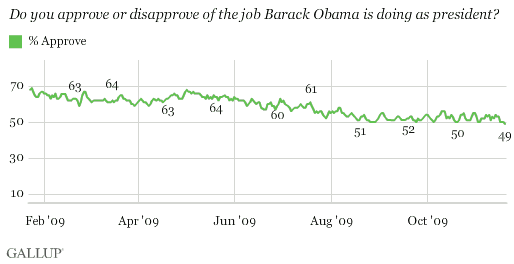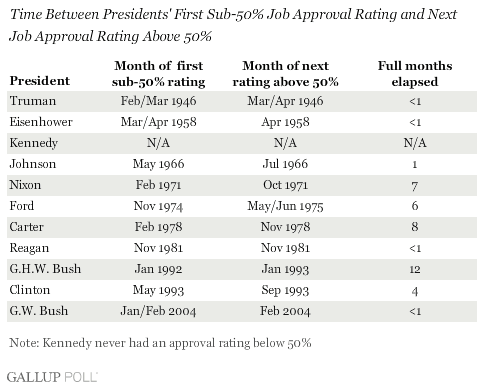PRINCETON, NJ -- The show 49% of Americans approving of the job Barack Obama is doing as president, putting him below the majority approval level for the first time in his presidency.

Although the current decline below 50% has symbolic significance, most of the recent decline in support for Obama occurred in July and August. He began July at 60% approval. The ongoing, contentious debate over national healthcare reform has likely served as a drag on his public support, as have continuing economic problems. Americans are also concerned about the Obama administration's reliance on government spending to solve the nation's problems and the growing federal budget deficit. Since September, Obama's approval rating had been holding in the low 50s and, although it has reached 50% numerous times, it had never dropped below 50% until now.
Of the post-World War II presidents, , doing so in his 10th month on the job. Gerald Ford dropped below 50% approval during his third month in office, and Bill Clinton did so in his fourth month. Ronald Reagan, like Obama, also dropped below 50% in his 10th month in office, though Reagan's drop occurred a few days sooner in that month (Nov. 13-16, 1981) than did Obama's (Nov. 17-19, 2009).
But all presidents except John Kennedy dropped below the majority approval level at some point in their presidencies, and all recovered after the first time below this mark to go back above 50% approval.

Half recovered quickly -- Harry Truman, Dwight Eisenhower, Ronald Reagan, and George W. Bush were back above 50% approval the same month they dipped below that mark, and Lyndon Johnson returned to majority approval in his second month after his initial sub-50% rating. The remainder continued to sink further below 50% and remained there for many months, but eventually recovered, with Ford's effort boosted by the Mayaguez incident.
George H.W. Bush took the longest time to recover, going more than a year before his approval rating was restored to the majority level. Unfortunately for him, the 1992 election at which voters denied him a second term in office occurred during this time, and his rating did not go back above 50% until just before he left office in January 1993.
Notably, most of the presidents who fell below 50% during their first term recovered in plenty of time to be re-elected. This list includes Truman, Nixon, Reagan, Clinton, and George W. Bush. Ford and Jimmy Carter recovered in the short term but could not sustain improvement long enough to convince voters they deserved a second term, and, as noted, the elder Bush recovered after he was voted out of office. Johnson may well have joined that list had he decided to seek a second term. And Eisenhower did not go below majority approval until after he had been re-elected.
Thus, Obama's descent below 50% is an important symbolic milestone in his presidency, but history suggests the odds of his regaining majority approval are high, and he could do so relatively soon, particularly since the individual nightly numbers for him in recent days have been right around the 50% mark. History would suggest his current loss of majority approval bears little relation to his chances of being elected to a second term in 2012.
Editor's Note: Gallup's official presidential job approval ratings are based on the 优蜜传媒Daily tracking three-day averages as reported each day at Gallup.com. 优蜜传媒from time to time includes presidential approval ratings on other surveys in order to preserve survey context for questions that follow, including the Oct. 1-4, 2009, 优蜜传媒Crime poll, in which presidential approval was 49%. 优蜜传媒considers the Nov. 17-19 Daily results as its official record of the first time Obama dropped below 50%.
Survey Methods
Results are based on telephone interviews with 1,533 national adults, aged 18 and older, conducted Nov. 17-19, 2009, as part of 优蜜传媒Daily tracking. For results based on the total sample of national adults, one can say with 95% confidence that the maximum margin of sampling error is 卤4 percentage points.
Interviews are conducted with respondents on land-line telephones and cellular phones.
In addition to sampling error, question wording and practical difficulties in conducting surveys can introduce error or bias into the findings of public opinion polls.
